As a speaker, you make every effort to make your presentation stand out – you add high-resolution images, well-researched content, animation, and whatnot, but despite this, sometimes your slideshow fails to hit the mark. Can you think of any reason? Poor design, lack of facial expression, and ineffective delivery of speech are the most probable reasons you will give for the presentation failure. Well, these are quite obvious reasons. Wait! Are you overlooking one important aspect that makes the presentation fall flat, i.e., the structure?
| A Quick Fact According to research studies, the information/data presented in a structured manner is retained 40% more precisely by the audience than the unstructured information/data. |
Every decent presentation follows a natural flow with a clear beginning, middle, and end, and appropriate transitions and signposts, which gives a direction to the audience and keeps them on track. However, creating a well-structured presentation is a daunting task and takes a lot of nerve as you have to consider a lot of factors – the objective of your presentation, whether you need any visual assistance, settings where you will be delivering your talk, knowledge of the audience level, time constraints for your speech, etc.
If you are not sure how to organize your slides to create an impact on the audience, you have landed at the right place. In this blog post, we have provided some outstanding ways to structure your presentation. Let’s dive deeper!
1. Situation-Complication-Resolution
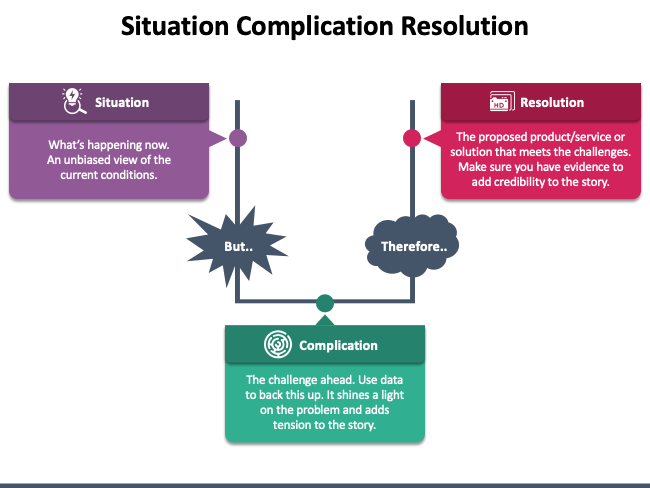
Image Source:
https://www.presentation-guru.com/wp-content/uploads/2016/05/Situation-Complication-Resolution.jpg
This structure is the best fit for presentations that aim to persuade the audience. It first describes the current scenario (more precisely, what’s going on at present) and then introduces the audience to the complication or problem (causes and impact). Then portray the solution of the problem (the steps, resources, and time required to solve it, the objections you may encounter, etc.). Finally, visualize the benefits after the resolution of the problem. You can make the presentation more intriguing by backing up your information with real-life examples, proof, and facts.
To sum up, the flow of information in this structure goes this way:
- Situation – The current scenario is represented with clarity.
- Complication – The challenge/problem that needs to be solved.
- Resolution – It depicts the solution to the problem.
Example: In his TED talk, Paul Greenberg beautifully presented how fishing salmon, tuna, and shrimp can ruin the oceans. He then suggested a few specific ways to overcome the problem that can benefit both nature and the people who earn their livelihoods through fishing.
2. Hook, Meat, and Payoff
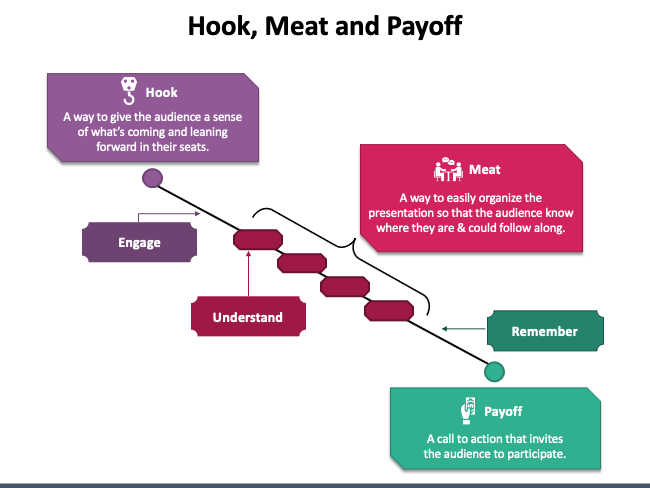
Image Source:
https://www.presentation-guru.com/wp-content/uploads/2016/05/Hook-Meat-and-payoff.jpg
In this presentation structure, the presenter opens his talk with something (like surprising information, less known facts, provocative statements, rhetorical questions, etc.) that keeps the audience hooked and wanting more. Gradually, the story progresses in an interesting way and finally ends with a conclusion that relates to the beginning.
- Hook – It develops the interest of the audience and piques their curiosity, giving them a strong reason to stay intrigued and listen.
- Meat – The main part of the presentation that describes what people actually need to understand.
- Payoff – The benefit or reward the audience gets after gaining new knowledge or developing a new understanding.
Example: To learn more about how this structure works, watch this presentation by Simon Sinek on “How Great Leaders Inspire Action.”
3. Situation-Opportunity-Resolution
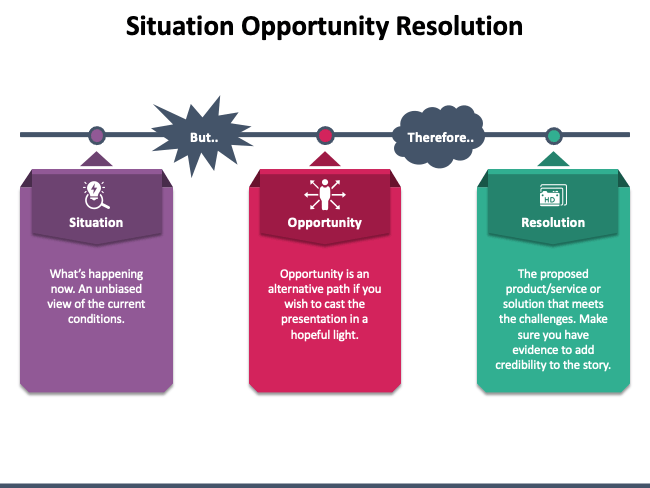
Image Source:
https://www.presentation-guru.com/wp-content/uploads/2016/05/Situation-Opportunity-Resolution.jpg
Every problem has an opportunity – this can be better represented by leveraging the Situation-Opportunity-Resolution structure. Instead of focusing more on the audience’s fear, it gives more attention to their aspirations.
- Situation – The current scenario is represented with clarity.
- Opportunity – The opportunity that must be grabbed to address the problem.
- Resolution – It depicts the solution to the problem. You can provide evidence and proof to increase the credibility of the story.
Example: Watch this TED talk by Adam Galinsky on “How to Speak Up for Yourself” to get more insights into this structure.
4. The Drama
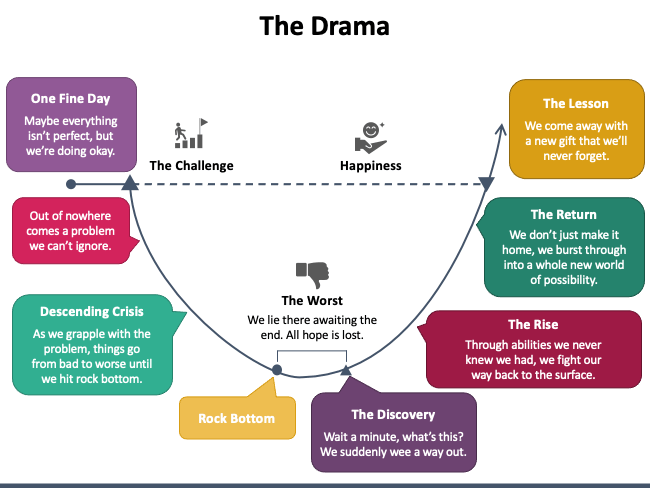
Image Source:
https://www.presentation-guru.com/wp-content/uploads/2016/05/The-Drama.jpg
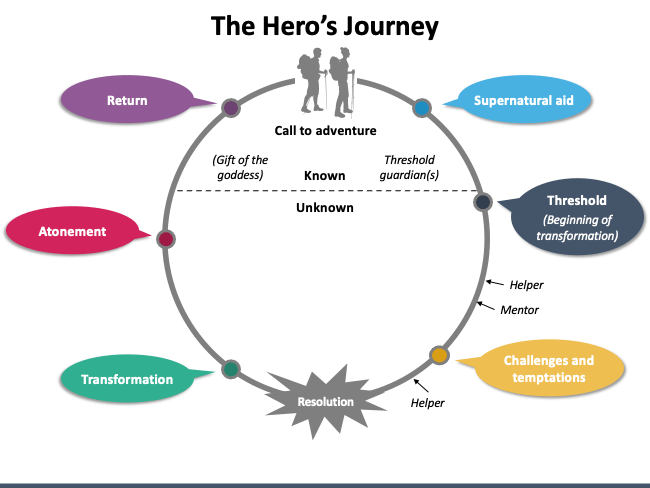
Image Source:
This structure is generally followed to present the success story of the business/individual. To be more precise, this structure depicts a Hero’s Journey – how he embarked on a voyage, what challenges/obstacles he encountered on the way, what unique things he discovered about himself, and what was the outcome of the entire voyage.
The entire story is narrated in the following 8 steps:
- One Fine Day – Depicts a stage situation that is not completely perfect, but just average.
- The Challenge – The challenge that comes suddenly and can’t be overlooked.
- Descending Crisis – How the challenge made things worse for the hero.
- Rock Bottom – Everything is at its worst, and the hero feels lost.
- The Discovery – A ray of hope (new abilities, skills, etc.) that makes the hero believe that the problem can be resolved.
- The Rise – How the problem can be resolved in a positive manner.
- The Return – How the hero overcomes the challenge and opens the way to a new range of possibilities for him.
- The Lesson – The key takeaway message that the hero gets from the entire journey.
Example: See how beautifully Adam Driver narrated his story of becoming an actor from Marines. This TED talk is the perfect example of this structure.
5. The Pitch
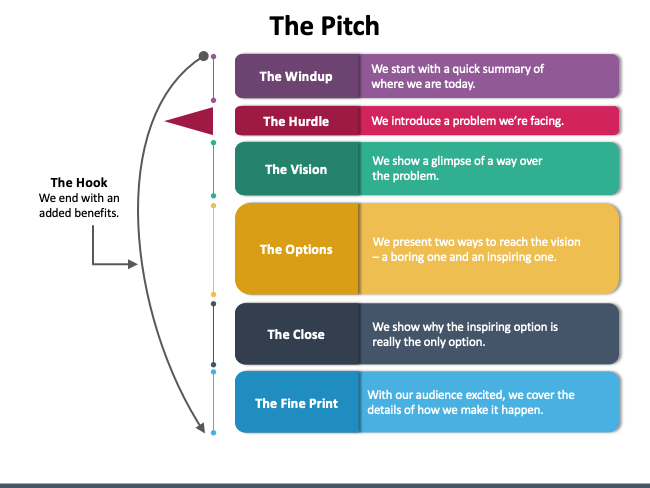
Image Source:
https://www.presentation-guru.com/wp-content/uploads/2016/05/The-pitch.jpg
The Pitch is perfect for sales presentations that aim to make the audience believe that the presenter’s idea can help them resolve their problem. The slideshow begins with the evaluation of the current situation and then proceeds towards the hurdles and the solution. You can include data, research, experiments, case studies, or use tests to support your ideas. Conclude your talk with the action that the audience is supposed to take next. Don’t forget to add a ‘hook’ (added benefit).
Here is a quick look at how this structure looks like:
- The Wind Up – A summary of the current scenario.
- The Hurdle – The problem/issue that needs to be resolved.
- The Vision – A quick glimpse into the main idea on how the problem/issue can be solved.
- The Options – Illustrates two different options to solve the problem.
- The Close – The best option is presented as the ideal solution to the problem.
- The Fine Print – Represents how exactly the problem will be resolved.
- The Hook – Showcases the ‘added benefit’ of the solution.
Example: Check out how Enric Sala pitched to solve the problem of turning the high seas into a natural reserve. He ended by making people aware of how people can contribute to their country.
6. The Explanation
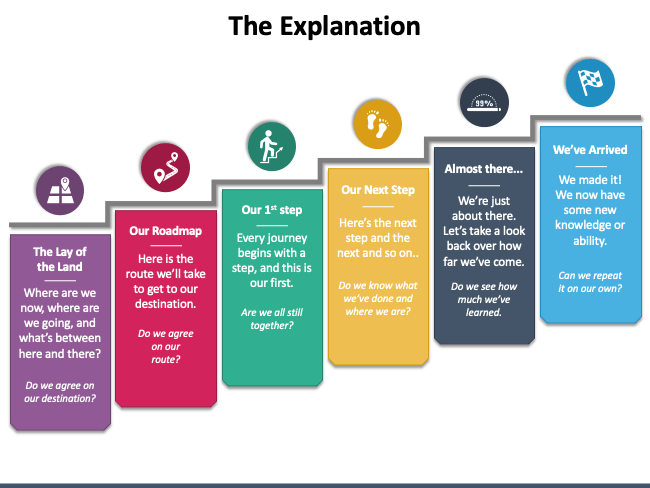
Image Source:
https://www.presentation-guru.com/wp-content/uploads/2016/05/the-explanation.jpg
This structure works best for crafting information-rich presentations that aim to educate the audience about a new regulation, initiative, insights, or process. The presentation progresses in an upward direction, depicting where we are now and where we need to reach or what we need to attain in the future. The steps to move to the next stage are showcased precisely, ensuring that the audience understands accurately how and why each stage affects or concerns them. The final stage of transformation is disclosed at the end. In a nutshell, this structure follows the following steps:
- The Lay of the Land – Where the things are now and what is the final destination.
- The Roadmap – The visual map that shows how to reach the final destination.
- The First Step – Instills the adventure to embark on the journey.
- The Next Step – Further steps are illustrated one by one.
- Almost There – Depicts how much you have progressed since the first step.
- The Arrival – Indicates the end of the journey.
Example: Watch this TED talk by Amy Cuddy, an American social psychologist. She followed an Explanation structure for delivering her talk on power poses and how they can impact the consequence of a difficult situation.
7. Fact and Storytelling
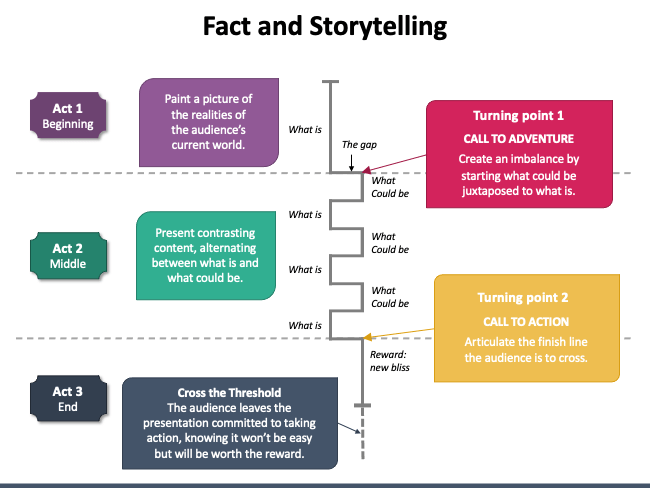
Image Source:
https://www.presentation-guru.com/wp-content/uploads/2016/05/Sparkline.jpg
If you are going to communicate your company’s or department’s vision or present an idea, product, or initiative, you can use this structure which follows a zig-zag pattern instead of a traditional linear one. Using this structure, you can zig-zag back and forth between ‘how things worked then’ and ‘how they would work in the future,’ giving momentum to your presentation. This structure focuses on concluding the slideshow on a high note.
Example: In 2007, Steve Jobs used the same structure for his keynote for launching the iPhone. He took advantage of the power of the unexpected to create a suspenseful opener and tease the audience. He threw light on what smartphones looked like and could do then and what they would look like and would do in the future. He finally demonstrated the iPhone in a very dramatic way.
Watch Steve Jobs’ full keynote below:
The Bottom Line
Some presentations leave you informed or inspired. This is because the speaker crafted the slides in a simple and logical manner that made it easy for you to grab the key takeaway message quickly.
A thoughtfully organized presentation benefits the speakers as well by helping them stay on topic, remain calm, avoid awkward silences, and deliver their talk with confidence. By choosing the right structure for your presentation, you can convert your boring information/data into an exciting story that appeals to your audience, both emotionally and intellectually. If you are presenting for the first time or have no time to craft a presentation from scratch, you can use pre-designed, high-definition templates to give a structured look to your information.
If you have something relevant to the topic you want to share with us, write in the “Comments” section below. And, if you like the blog post, do share it on your social media handles.
Looking For Powerpoint Design Agency?
Call Pursho @ 0731-6725516
Telegram Group One Must Follow :
For Startups: https://t.me/daily_business_reads
#Incredible #Ways #Structure #Presentation





